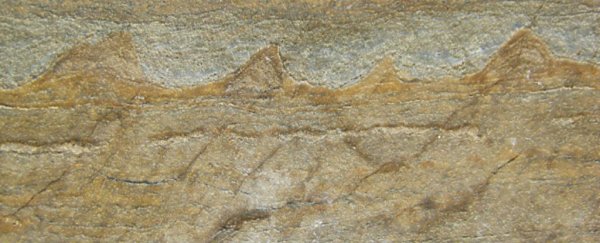The oldest fossils ever discovered have been found in Greenland, and they appear to have preserved the earliest signs of life of Earth.
Dated to around 3.7 billion years ago, the fossils contain evidence of stromatolites - layers of sediment packed together by ancient, water-based bacterial colonies - and could push back the origins of life in the fossil record by 220 million years.
Before this fossil was discovered, the oldest known evidence for life were 3.48 billion-year-old fossil stromatolites found in the Pilbara region in Western Australia.
"The significance of stromatolites is that not only do they provide obvious evidence of ancient life that is visible with the naked eye, but that they are complex ecosystems," said lead researcher Allen Nutman from the University of Wollongong in Australia.
"This indicates that as long as 3.7 billion years ago, microbial life was already diverse. This diversity shows that life emerged within the first few hundred millions years of Earth's existence, which is in keeping with biologists' calculations showing the great antiquity of life's genetic code."
The fossils were uncovered in the oldest known sedimentary rocks in the world, locked in the Isua Greenstone Belt, which runs along the edge of Greenland's icecap.
While these rocks have been studied for decades, the fossils were obscured from view by constant snow fall, but Nutman and his team got there at just the right time to see the snow and ice begin to melt away.
The fossils, which have been cut away from the rocky outcrop and are now under analysis in Australia, contain tiny cones, just 1 to 4 centimetres tall, and the researchers say their structures and internal layering look exactly like other ancient and modern stromatolites.
"The texture of the surrounding rocks suggests that they were laid down at the bottom of a shallow sea, much as stromatolites are today in places such as the Bahamas and Western Australia," Alexandra Witze explains for Nature.
"And the rocks contain carbonate minerals such as dolomite, which are also common in younger stromatolites."
If the team can confirm that these really are the ancient marks of 3.7-billion-year-organisms, it's going to make life difficult for those tasked with explaining how evolution could have produced such relatively complex organisms so early on in Earth's lifespan.
To have had time to evolve into organisms associated with stromatolites formations, Nutman and his team suggest that life on Earth would have likely originated during the Hadean stage of our planet's history, which runs from Earth's formation around 4.65 billion years ago - when debris in orbit around the Sun accumulated into our planet - to around 4 billion years ago.
But there was nothing pleasant about Earth during that time. As Nicholas Wade reports for The New York Times, evidence suggests that it was being constantly bombarded with asteroids so destructive that one even cracked a chunk off Earth to form our Moon.
Researchers have been debating for years over how long these relentless showerings of asteroids lasted, and Nutman argues that they probably would have slowed down over time, making things slightly easier for life to evolve.
That could well be the case, but we do have evidence of a catastrophic event that saw the Hadean go out not with one bang, but several bangs, just before the Isua creatures would have existed.
"[E]ven when the Hadean ended, a final rain of large asteroids descended on Earth at the beginning of the ensuing Archaean stage, possibly set loose when the giant planets Saturn, Uranus, and Neptune drifted out into the Kuiper belt of asteroids," says Wade.
"This cataclysm, known as the Late Heavy Bombardment, hit Earth between 3.9 and 3.8 billion years ago."
So how did life evolve through all of this chaos? The team will now have to find supporting evidence that their fossils contain signs of ancient life, because while there's a case to be made, not everyone is convinced.
"I've got 14 queries and problems that need addressing before I'll believe it," Roger Buick, a geobiologist at the University of Washington, who was not involved in the research, told Alexandra Witze at Nature.
"If we found something like this on Mars would we stick a flag in it and call it life? I don't think we would," adds Abigail Allwood, an astrobiologist at NASA's Jet Propulsion Laboratory in California.
"Having said that, it's incredible that anything can be found in these rocks that are barely a ghost of what they were before. That's why it's worthy of attention."
The team plans on returning to the site to see if there are more signs of life in the area surrounding the fossils. Allwood says their case would be made a whole lot stronger if they can find deposits of organic matter that would have accompanied the bacteria along with their stromatolite formations.
We'll just have to wait and see what they find.
The research has been published in Nature.
